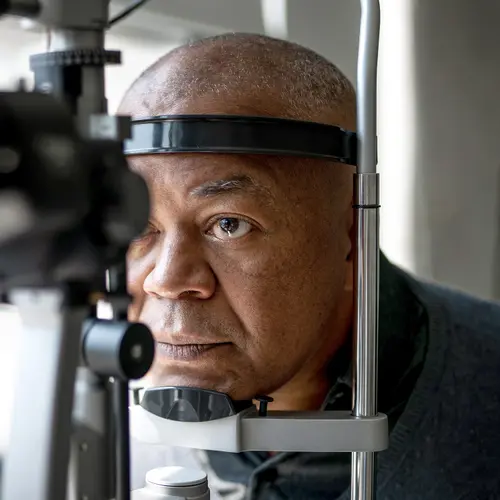Amy Atcha, 47, began to suspect there was something wrong when her 72-year-old mother, Judith Arcy, wasn't able to read a menu or see the numbers on her cell phone. After a visit to the ophthalmologist, her mother's diagnosis turned out to be age-related dry macular degeneration (AMD), a chronic, degenerative eye disease that causes central vision loss.
AMD "doesn't come on all of a sudden," explains David M. Kleinman, MD, MBA, associate professor of ophthalmology at the Flaum Eye Institute, University of Rochester Medical Center, in Rochester, N.Y. With AMD, light-sensitive cells in the macula (the area responsible for seeing fine detail when you look straight ahead) gradually begin to deteriorate and die.
As the disease progresses, blind or blurry spots can appear in the center of your vision, making it difficult to read, drive, or even recognize faces. These blind spots can get bigger as the disease progresses. (Another form of the disease, wet AMD, is less common but often progresses more rapidly.) If you notice these signs, see an eye doctor for an exam.
"If you are diagnosed with early AMD, you can decrease the chances of losing vision," says Kleinman. "But you have to change your lifestyle." Here's how:
Quit the habit. "The first step is, clearly, don't smoke," says Kleinman. If you do, a quit-smoking program can help you stop, he suggests. Studies show that smokers have two to three times the risk of developing AMD than nonsmokers.
Eat a rainbow of brightly colored fruits and vegetables. "They have antioxidants that are very protective and supportive of retinal health," says Kleinman. Dark green leafy vegetables such as kale and Swiss chard are excellent choices, but spinach is "a pretty good surrogate," he says. A diet that includes fatty fish such as salmon and tuna, high in omega-3 fatty acids, may also help prevent AMD from progressing, according to the National Eye Institute (NEI).
Get regular checkups. Make appointments with your ophthalmologist, as well as your primary care doctor, to check cholesterol and blood pressure. Maintaining normal blood pressure and cholesterol may be helpful to slow progression of AMD, according to the NEI. Some research suggests that high blood pressure and high cholesterol may put the eyes at risk for AMD, explains Kleinman.
Consider a supplement. People with moderate AMD showed a 25% lower risk of vision loss when they took a formula of certain antioxidants and zinc, according to a 10-year clinical trial by the NEI. Talk to your doctor about the AREDS formula (from the Age-Related Eye Disease Study) to see if it might be right for you.
Get moving. The CDC recommends 150 minutes of exercise per week, but simply walking more may help, says Kleinman. Though researchers haven't proven exercise can slow AMD, it "helps maintain blood pressure, and keeps the blood vessels open and working," he explains. That means exercise may be as beneficial for eye health as it is for the rest of the body.
Wear a hat. Although studies haven't proven a cause-and-effect relationship between sunlight exposure and AMD, research suggests that protecting your eyes may be beneficial. "I recommend wearing a hat and sunglasses when outside on sunny days," says Kleinman.
Stay positive. People rarely go completely blind with AMD, he says. If your vision is deteriorating, a service that assists people with visual impairment can help with magnifiers or electronic readers, he says.
DYK: An estimated 10 million Americans have or are at risk for AMD, the leading cause of vision loss in people over age 55, according to the Foundation Fighting Blindness
Find more articles, browse back issues, and read the current issue of "WebMD Magazine."

